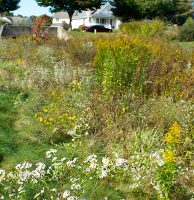
Restoring Ecosystem Functions in Central Pennsylvania and Beyond
At LandStudies, our work focuses on restoring natural systems so they can provide valuable ecosystem services for local municipalities and their residents. Ecosystem services are traditionally lumped into four categories:
- Provisioning, which includes the production of food and water
- Regulating, such as the control of climate and disease
- Supporting, which includes nutrient cycles and crop pollination
- Cultural, such as spiritual and recreational benefits
Our work can provide ecosystem services within each of the four categories. In this article we will explore those benefits and what it means for Pennsylvania citizens.
Provisioning Services
Restoring stream and river floodplains and riparian buffers helps to clean our waterways, which can aid in the production of potable water (and reduce treatment costs for drinking water treatment plants). Examples of our related work can be found here. These riparian buffers can be planted in such a way to include edible crops such as walnuts, blueberries, and paw paws, while still protecting water quality. The Department of Conservation and Natural Resources (DCNR) is encouraging the planting of such buffers and offers some grants for them. More information can be found here.
Regulating Services
Trees reduce the impact of greenhouse gases by absorbing carbon dioxide from the atmosphere and producing clean oxygen for us to breathe. When we install riparian buffers, stormwater best management practices (BMPs), and other landscape design projects, we incorporate a variety of tree species to not only help improve air quality but also to filter out pollutants through their roots, stabilize the soil, and provide wildlife habitat. Projects like Butterfly Acres and the Rife Run restoration are good examples of the benefits of tree plantings. More can be found here.
Supporting Services
Many of our crops are pollinated by butterflies and other insects. These pollinators also rely on a variety of native plants as a source of food. Our use of native plants in our restoration and new construction projects provides food and habitat for pollinators, which will then go on to pollinate our food crops. These same plants can also enhance the nutrient cycle by the presence of beneficial bacteria and microorganisms in their root systems, making nutrients more readily available for plant uptake. The Chestnut Grove Natural Area restoration provides one example of this transformation. Read about it here.
Cultural Services
Integrating recreational opportunities into restoration projects is a great way to get people outdoors while educating them about the benefits of floodplains, riparian buffers, and native plants. LandStudies has completed numerous restoration projects for parks and golf courses that allow ecosystems to function properly while also providing recreational benefits to visitors. You can learn more about these myriad projects here.
These four categories of ecosystem services are intertwined to provide maximum benefits for people and the environment. LandStudies will continue to work with our clients to create the biggest bang for their buck and improve ecosystems across the Pennsylvanian landscape.



